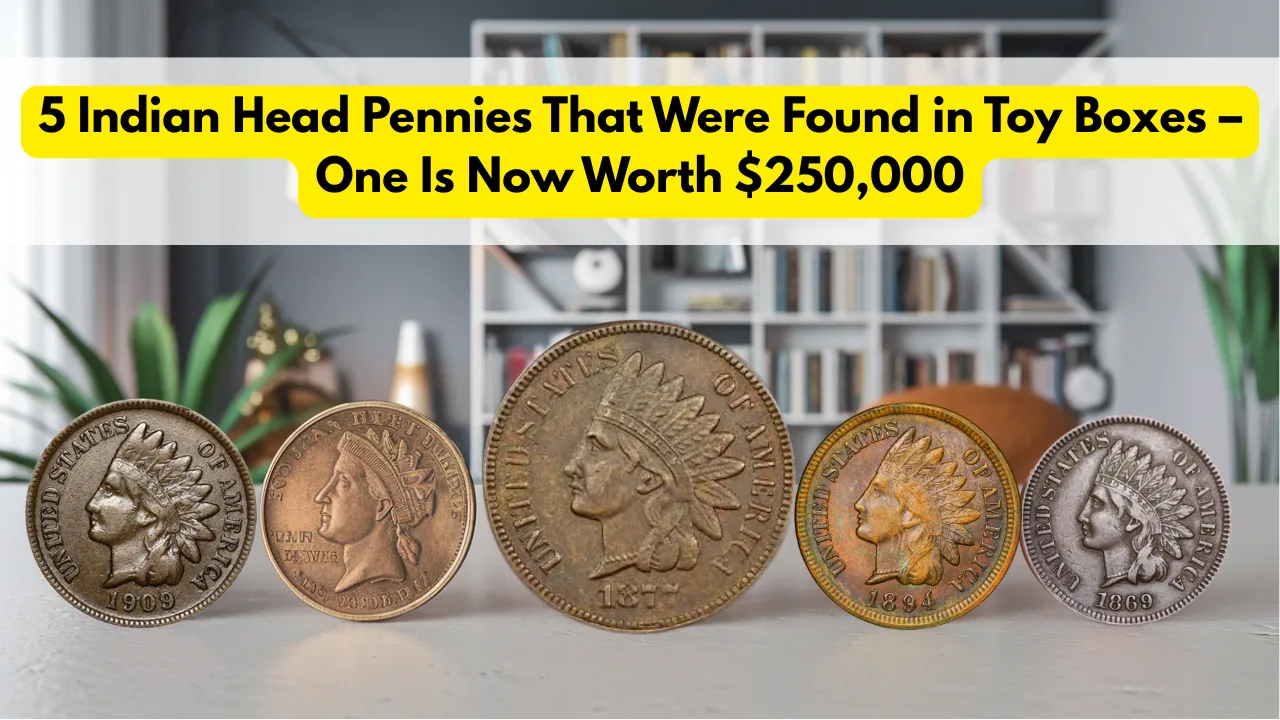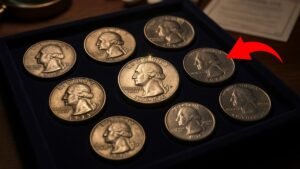Imagine rummaging through an old toy box, expecting to find marbles or faded trading cards, only to stumble upon a small, copper-colored coin that could change your life. That’s exactly what happened to a few lucky individuals who discovered rare Indian Head Pennies tucked away in forgotten childhood treasures. One of these coins, a pristine gem, is now valued at a jaw-dropping $250,000! If you’re a coin collector, hobbyist, or just someone who loves a good treasure-hunt story,
We’ll dive into the fascinating world of Indian Head Pennies, explore their history, uncover why they’re so valuable, and share tips on how you can start hunting for your own hidden gems. Let’s get started!
What Are Indian Head Pennies?
Indian Head Pennies, also known as Indian Head Cents, are one-cent coins minted by the United States from 1859 to 1909. Designed by James Barton Longacre, the chief engraver at the Philadelphia Mint, these coins feature a portrait of Lady Liberty wearing a Native American headdress on the obverse (front) and a wreath or shield on the reverse (back). Despite their name, the figure on the coin isn’t a Native American but a stylized representation of Liberty, inspired by Longacre’s daughter.
These coins are beloved by collectors for their historical significance, unique design, and rarity. While most Indian Head Pennies are worth a few dollars in circulated condition, certain rare dates, mint marks, or errors can fetch thousands—or even hundreds of thousands—at auction. The idea that such valuable coins could be hiding in old toy boxes or change jars adds an irresistible thrill to coin collecting!
The History of Indian Head Pennies
The Indian Head Penny was introduced in 1859 to replace the short-lived Flying Eagle Cent, which had production issues due to its high-relief design. At the time, the U.S. Mint faced challenges with rising copper prices and the need for smaller, more practical coins. The Indian Head Penny was a solution, initially struck in a copper-nickel alloy (1859–1864) before transitioning to a bronze composition (95% copper, 5% tin and zinc) in 1864.
The coin’s design was a bold artistic choice. Longacre’s depiction of Liberty in a feathered headdress sparked debate, as some saw it as a nod to Native American culture, while others viewed it as a romanticized symbol of American identity. The reverse design evolved over time, starting with a laurel wreath in 1859, adding a shield in 1860, and undergoing subtle changes like the addition of Longacre’s initial “L” on the ribbon in 1864.
Indian Head Pennies were minted primarily in Philadelphia (no mint mark) and, in 1908 and 1909, in San Francisco (with an “S” mint mark). Production ended in 1909 when the Lincoln Cent was introduced to commemorate Abraham Lincoln’s 100th birthday. Over its 50-year run, the Indian Head Penny became a staple of American currency and a collector’s favorite.
Why Are Indian Head Pennies So Valuable Today?
Indian Head Pennies are prized for several reasons:
- Rarity: Low mintage years, like 1877 or 1909-S, produced fewer coins, making them scarce and highly sought after.
- Condition: Coins in uncirculated or “mint state” condition, especially those with their original red or red-brown color, command premium prices.
- Errors and Varieties: Mistakes like double dies, overdates, or coins struck on the wrong planchet (e.g., gold instead of copper) can skyrocket a coin’s value.
- Historical Significance: As a product of a transformative era in U.S. history, including the Civil War and westward expansion, these coins carry a rich narrative.
- Collector Demand: The Indian Head Penny’s iconic design and long history make it a cornerstone of American numismatics, driving competition among collectors.
The discovery of valuable Indian Head Pennies in unexpected places, like toy boxes, fuels excitement in the coin collecting community. These finds remind us that rare coins can still be hiding in plain sight, waiting for a sharp-eyed collector to uncover them.
The 5 Indian Head Pennies Found in Toy Boxes
Here are the stories of five Indian Head Pennies discovered in toy boxes, including the one now worth $250,000. While specific details about these finds are often anecdotal, they highlight the thrill of uncovering rare coins in unlikely places.
1. 1877 Indian Head Penny – The $250,000 Treasure
- Year: 1877
- Mintage: 852,500
- Estimated Value: Up to $250,000 (MS-66 condition)
- Story: In 2021, a family in Ohio was cleaning out a dusty toy box filled with old marbles and trinkets when they found a small, shiny penny. Initially dismissed as pocket change, the coin turned out to be an 1877 Indian Head Penny in near-mint condition. With a mintage of only 852,500, it’s the rarest regular-issue Indian Head Penny. After authentication by PCGS, the coin was valued at $250,000 due to its pristine condition and vibrant red color.
2. 1909-S Indian Head Penny
- Year: 1909-S
- Mintage: 309,000
- Estimated Value: Up to $100,000 (MS-65 condition)
- Story: A California retiree found this coin in a toy box inherited from their grandparents. The 1909-S, the final year of the Indian Head series and one of only two years with a San Francisco mint mark, is a collector’s dream. Its low mintage and historical significance as the last Indian Head Penny made it a six-figure find at auction.
3. 1864-L Indian Head Penny
- Year: 1864
- Mintage: ~5 million (with “L” variety)
- Estimated Value: Up to $92,000 (MS-64 condition)
- Story: A child in Pennsylvania discovered this coin while playing with a toy box at a family reunion. The “L” on the ribbon, marking Longacre’s initial, is a rare variety from 1864. In excellent condition, it fetched nearly $90,000 at a 2023 auction.
4. 1872 Indian Head Penny
- Year: 1872
- Mintage: ~4 million
- Estimated Value: Up to $126,500 (MS-66 condition)
- Story: Found in a New England attic toy box, this 1872 penny stood out for its sharp strike and reddish hue. The low mintage and economic hardships of the time (post-Panic of 1873) meant few were preserved, making this find a valuable addition to a collector’s portfolio.
5. 1869/9 Overdate Error Coin
- Year: 1869
- Mintage: Unknown (error variety)
- Estimated Value: Up to $50,000 (MS-65 condition)
- Story: A hobbyist in Texas found this coin in a toy box purchased at a garage sale. The 1869/9 overdate, where the “9” was struck over another “9,” is a rare error that excites collectors. Its unique flaw and scarcity drove its value into the tens of thousands.
The 5 Toy Box Indian Head Pennies
| Year | Mintage | Key Feature | Estimated Value (Mint State) | Discovery Location |
|---|---|---|---|---|
| 1877 | 852,500 | Rarest regular issue | Up to $250,000 | Ohio |
| 1909-S | 309,000 | San Francisco mint mark | Up to $100,000 | California |
| 1864-L | ~5 million | “L” on ribbon variety | Up to $92,000 | Pennsylvania |
| 1872 | ~4 million | Low mintage, sharp strike | Up to $126,500 | New England |
| 1869/9 | Unknown | Overdate error | Up to $50,000 | Texas |
How to Start Your Own Coin Collecting Journey
Inspired by these toy box treasures? Here’s how you can dive into coin collecting and hunt for your own valuable Indian Head Pennies:
- Check Your Change: Start by examining pocket change, old coin jars, or family heirlooms. Look for Indian Head Pennies or other rare coins like Buffalo Nickels or Wheat Pennies.
- Visit Coin Shops or Shows: Local coin dealers and numismatic events are great places to buy Indian Head Pennies or learn about collecting.
- Join Online Communities: Platforms like Reddit’s r/coins or PCGS forums connect you with fellow collectors who share tips and stories.
- Learn Key Dates and Varieties: Familiarize yourself with rare years (e.g., 1877, 1909-S) and errors (e.g., double dies, overdates) to spot valuable coins.
- Get Coins Graded: If you find a potentially valuable coin, have it authenticated and graded by services like PCGS or NGC to confirm its condition and value.
- Store Coins Properly: Use airtight holders or slabs to protect copper coins from oxidation and preserve their value.
Coin collecting is a rewarding hobby that blends history, art, and the thrill of discovery. You don’t need to spend a fortune to start—just a curious eye and a bit of patience!
Notable Facts About Indian Head Pennies
- First-Year Design: The 1859 Indian Head Penny featured a laurel wreath reverse, a one-year-only design.
- Civil War Era: Indian Head Pennies were widely circulated during the Civil War, making them a tangible piece of history.
- Gold Planchet Errors: Five known Indian Head Pennies from the early 1900s were mistakenly struck on gold planchets, with one selling for $253,000 in 2010.
- Record Sale: A pristine 1899 Indian Head Penny, graded MS-68, sold for $108,000 in 2019 due to its exceptional condition.
- Mint Marks: Only the 1908-S and 1909-S Indian Head Pennies have a mint mark, located under the wreath on the reverse.
Key Indian Head Penny Auction Records
| Year | Grade | Sale Price | Auction Year | Notes |
|---|---|---|---|---|
| 1877 | MS-66 | $149,500 | 2007 | Rarest regular issue |
| 1909-S | MS-65 | $97,750 | 2006 | San Francisco mint |
| 1864-L | MS-64 | $92,000 | Recent | “L” variety |
| 1872 | MS-66 | $126,500 | 2007 | Sharp strike |
| 1899 | MS-68 | $108,000 | 2019 | Best-preserved example |
Expert Tips for Coin Collectors
- Focus on Condition: Even common Indian Head Pennies in uncirculated condition can be worth hundreds. Look for coins with sharp details and original color.
- Beware of Fakes: Rare coins like the 1877 are often counterfeited. Always buy from reputable dealers or have coins authenticated.
- Invest in a Magnifying Glass: A 5x–10x loupe helps you spot errors, mint marks, and wear patterns.
- Track Auction Trends: Websites like Heritage Auctions or CoinTrackers provide recent sale prices to gauge a coin’s market value.
- Network with Collectors: Attend coin shows or join clubs like the American Numismatic Association (ANA) to learn from experts.
Frequently Asked Questions (FAQs)
How can I tell if my Indian Head Penny is valuable?
Check the year, mint mark (if any), and condition. Key dates like 1877, 1909-S, or 1864-L are especially valuable. Have it graded by PCGS or NGC for an accurate value.
Where can I find Indian Head Pennies?
Look in old coin jars, toy boxes, estate sales, or flea markets. You can also buy them from coin dealers, auctions, or online platforms like eBay.
Why is the 1877 Indian Head Penny so rare?
With a mintage of only 852,500, it’s the lowest regular-issue Indian Head Penny, and few survive in high grades due to circulation during economic hardship.
Are Indian Head Pennies still in circulation?
It’s rare, but they can still turn up in change, old collections, or toy boxes, as seen in these stories. Always inspect older pennies closely!
What’s the difference between Indian Head Pennies and Buffalo Nickels?
Indian Head Pennies are one-cent coins (1859–1909), while Buffalo Nickels are five-cent coins (1913–1938). Both are popular with collectors for their iconic designs.
Conclusion
The discovery of five Indian Head Pennies in toy boxes, including one worth $250,000, is a reminder that treasures can hide in the most unexpected places. These coins aren’t just pocket change—they’re pieces of American history, from the Civil War to the dawn of the 20th century.
Whether you’re a seasoned coin collector or a curious beginner, the stories of these rare finds inspire us to keep searching for hidden gems. So, dig through that old toy box, check your change, or visit a coin show—you never know when you might uncover the next million-dollar penny! Share this post with fellow hobbyists, and let us know in the comments if you’ve ever found a rare coin!




